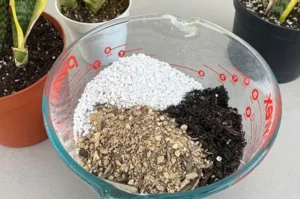Snake plants (also known as Sansevieria or mother-in-law’s tongue) are loved for their upright, sword-like leaves and low maintenance needs. But sometimes, instead of standing tall, their leaves begin to bend, droop, or lean to the side. If you’re facing this issue, don’t worry — it’s fixable!
In this guide, you’ll learn the reasons behind floppy snake plant leaves and practical steps to help your plant grow straight and healthy.
What Causes Snake Plant Leaves to Bend or Fall Over?
Before solving the problem, it helps to understand why it happens. Several common issues can cause snake plant leaves to lean or collapse.
1. Lack of Light
Snake plants can live in low-light spaces, but that doesn’t mean they thrive there. When they don’t get enough light, their leaves weaken and start to droop.
2. Too Much Water
Overwatering is a leading cause of problems. If the soil stays soggy, roots begin to rot. This weakens the plant, making it unable to support the leaves.
3. Poor Soil and Drainage
Heavy or poorly draining soil traps water, which leads to root rot. Without healthy roots, the plant can’t grow upright.
4. Overgrown or Top-Heavy Leaves
As snake plants grow, their tall leaves can become heavy, especially if new growth is concentrated on one side.
5. Wrong Pot Size
A pot that’s too big can hold excess water, while one that’s too small might not offer enough space for stable root development.
How to Encourage Upright Snake Plant Growth
If your plant is already leaning or drooping, here are several steps to help it regain its upright shape.
1. Give It Proper Light
Place your snake plant in an area that receives bright, indirect light, such as near a window with sheer curtains. If the light is too dim, consider using a grow light.
Tip: Rotate the plant every week so it doesn’t lean toward one direction.
2. Fix Your Watering Routine
Let the soil dry out completely between waterings. Stick your finger about 2–3 inches into the soil if it feels dry, it’s time to water. Avoid watering on a fixed schedule.
Overwatering weakens the roots, making it hard for the plant to support itself.
3. Improve the Soil Mix
Use a well-draining soil, such as a cactus or succulent mix. You can also create your own by combining:
- 2 parts potting mix
- 1 part perlite or coarse sand
- 1 part coco coir or peat moss
This allows water to drain quickly and keeps the roots healthy.
4. Repot When Needed
If your snake plant has outgrown its container or is root-bound, repot it into a container just slightly larger. Always use pots with drainage holes.
Terracotta pots are ideal since they absorb excess moisture and prevent overwatering issues.
5. Support the Leaves
Use plant ties or soft string to gently secure the leaning leaves to a wooden or bamboo stick placed in the soil.
Make sure the ties are loose and not cutting into the leaves.
6. Prune Damaged Leaves
If any leaves are heavily bent or soft, prune them at the base with a sterilized knife or scissors. Removing damaged leaves allows the plant to focus energy on new, stronger growth.
You can even use the healthy parts of trimmed leaves to propagate new plants in water or soil.
7. Keep a Stable Environment
Snake plants prefer temperatures between 60°F to 85°F (15°C to 29°C). Avoid placing them near cold drafts or heating vents, which can stress the plant.
Humidity isn’t a big issue for snake plants, but extremely dry or wet air may affect growth.
What to Avoid
Avoid these common mistakes that can cause your snake plant to lean:
- Watering too often or using pots with no drainage
- Placing the plant in dark, isolated corners
- Letting the plant grow too tall without support
- Ignoring signs of root rot, like mushy leaves or a foul smell
Conclusion
Keeping your snake plant’s leaves standing tall is simple once you understand what it needs. Focus on the basics: proper light, correct watering, well-draining soil, and occasional pruning. If the plant is already drooping, support it with stakes and improve its environment.
With the right care, your snake plant will reward you with healthy, upright leaves and a bold, sculptural look that enhances any indoor space.







1 thought on “How to Get Snake Plants to Grow Straight”
I’m happy I found have a snake plant in my bedroom helps me to sleep all night!
I love plants.